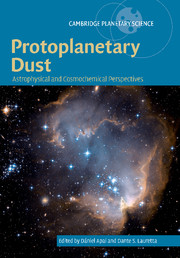Book contents
- Frontmatter
- Contents
- List of contributing authors
- Preface
- Acknowledgments
- 1 Planet formation and protoplanetary dust
- 2 The origins of protoplanetary dust and the formation of accretion disks
- 3 Evolution of protoplanetary disk structures
- 4 Chemical and isotopic evolution of the solar nebula and protoplanetary disks
- 5 Laboratory studies of simple dust analogs in astrophysical environments
- 6 Dust composition in protoplanetary disks
- 7 Dust particle size evolution
- 8 Thermal processing in protoplanetary nebulae
- 9 The clearing of protoplanetary disks and of the proto-solar nebula
- 10 Accretion of planetesimals and the formation of rocky planets
- Appendix 1 Common minerals in the Solar System
- Appendix 2 Mass spectrometry
- Appendix 3 Basics of light absorption and scattering theory
- Glossary
- Index
Preface
Published online by Cambridge University Press: 24 February 2010
- Frontmatter
- Contents
- List of contributing authors
- Preface
- Acknowledgments
- 1 Planet formation and protoplanetary dust
- 2 The origins of protoplanetary dust and the formation of accretion disks
- 3 Evolution of protoplanetary disk structures
- 4 Chemical and isotopic evolution of the solar nebula and protoplanetary disks
- 5 Laboratory studies of simple dust analogs in astrophysical environments
- 6 Dust composition in protoplanetary disks
- 7 Dust particle size evolution
- 8 Thermal processing in protoplanetary nebulae
- 9 The clearing of protoplanetary disks and of the proto-solar nebula
- 10 Accretion of planetesimals and the formation of rocky planets
- Appendix 1 Common minerals in the Solar System
- Appendix 2 Mass spectrometry
- Appendix 3 Basics of light absorption and scattering theory
- Glossary
- Index
Summary
Some fundamental questions are surprisingly simple: Where did we come from? Are we alone in the Universe? These two simple questions have been pondered on and debated over by hundreds of generations. Yet, these questions proved to be very difficult to answer. Today, however, they have shifted from the realm of religious and philosophical discussions to the lecture rooms and laboratories of hard sciences: they are, indeed, among the drivers of modern astrophysics and planetary sciences.
Fortunately, and perhaps surprisingly, the Universe provides a means to address these important questions. Today we are witnessing as the answers emerge to these age-old questions. We now know that asteroids and comets of the Solar System have preserved a detailed record of the dramatic events that four billion years ago gave birth to our planetary system in only a few million years. Gravity and radiation pressure conspire to deliver almost pristine samples of the early Solar System to Earth in the form of meteorites and interplanetary dust particles. We have also taken this process one step further with the successful return of particles from the coma of comet Wild 2 by NASA's Stardust mission. Detailed chemical and mineralogical analyses of these materials allow for the reconstruction of the history of our planetary system.
We can address the questions of the ubiquity of planetary systems in our galaxy by comparing the conditions and events of the early Solar System to circumstellar disks in star-forming regions. Technological wonders, such as the Hubble and Spitzer space telescopes, have allowed direct imaging of disks in which planetary systems are thought to form and enable comparative mineralogy of dust grains hundreds of light years away.
- Type
- Chapter
- Information
- Protoplanetary DustAstrophysical and Cosmochemical Perspectives, pp. xv - xviiPublisher: Cambridge University PressPrint publication year: 2010

